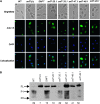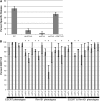Mutational analysis of Candida albicans SNF7 reveals genetically separable Rim101 and ESCRT functions and demonstrates divergence in bro1-domain protein interactions
- PMID: 20026677
- PMCID: PMC2845337
- DOI: 10.1534/genetics.109.112029
Mutational analysis of Candida albicans SNF7 reveals genetically separable Rim101 and ESCRT functions and demonstrates divergence in bro1-domain protein interactions
Abstract
The opportunistic pathogen Candida albicans can grow over a wide pH range, which is associated with its ability to colonize and infect distinct host niches. C. albicans growth in neutral-alkaline environments requires proteolytic activation of the transcription factor Rim101. Rim101 activation requires Snf7, a member of the endosomal sorting complex required for transport (ESCRT) pathway. We hypothesized that Snf7 has distinct functions in the Rim101 and ESCRT pathways, which we tested by alanine-scanning mutagenesis. While some snf7 alleles conferred no defects, we identified alleles with solely ESCRT-dependent, solely Rim101-dependent, or both Rim101- and ESCRT-dependent defects. Thus, Snf7 function in these two pathways is at least partially separable. Both Rim101- and ESCRT-dependent functions require Snf7 recruitment to the endosomal membrane and alleles that disrupted both pathways were found to localize normally, suggesting a downstream defect. Most alleles that conferred solely Rim101-dependent defects were still able to process Rim101 normally under steady-state conditions. However, these same strains did display a kinetic defect in Rim101 processing. Several alleles with solely Rim101-dependent defects mapped to the C-terminal end of Snf7. Further analyses suggested that these mutations disrupted interactions with bro-domain proteins, Rim20 and Bro1, in overlapping but slightly divergent Snf7 domains.
Figures










Similar articles
-
The Candida albicans ESCRT pathway makes Rim101-dependent and -independent contributions to pathogenesis.Eukaryot Cell. 2010 Aug;9(8):1203-15. doi: 10.1128/EC.00056-10. Epub 2010 Jun 25. Eukaryot Cell. 2010. PMID: 20581294 Free PMC article.
-
Control of Bro1-domain protein Rim20 localization by external pH, ESCRT machinery, and the Saccharomyces cerevisiae Rim101 pathway.Mol Biol Cell. 2006 Mar;17(3):1344-53. doi: 10.1091/mbc.e05-10-0949. Epub 2006 Jan 11. Mol Biol Cell. 2006. PMID: 16407402 Free PMC article.
-
Multivesicular body-ESCRT components function in pH response regulation in Saccharomyces cerevisiae and Candida albicans.Mol Biol Cell. 2004 Dec;15(12):5528-37. doi: 10.1091/mbc.e04-08-0666. Epub 2004 Sep 15. Mol Biol Cell. 2004. PMID: 15371534 Free PMC article.
-
The signaling mechanism of ambient pH sensing and adaptation in yeast and fungi.FEBS J. 2012 Apr;279(8):1407-13. doi: 10.1111/j.1742-4658.2012.08548.x. Epub 2012 Mar 23. FEBS J. 2012. PMID: 22360598 Review.
-
Adaptation to environmental pH in Candida albicans and its relation to pathogenesis.Curr Genet. 2003 Oct;44(1):1-7. doi: 10.1007/s00294-003-0415-2. Epub 2003 Jun 18. Curr Genet. 2003. PMID: 12819929 Review.
Cited by
-
Morphology Changes in Human Fungal Pathogens upon Interaction with the Host.J Fungi (Basel). 2017;3(4):66. doi: 10.3390/jof3040066. Epub 2017 Dec 1. J Fungi (Basel). 2017. PMID: 29333431 Free PMC article.
-
Pullulan nanoparticles inhibit the pathogenicity of Candida albicans by regulating hypha-related gene expression.Microbiol Spectr. 2024 Nov 14;12(12):e0104824. doi: 10.1128/spectrum.01048-24. Online ahead of print. Microbiol Spectr. 2024. PMID: 39540747 Free PMC article.
-
Shuttle vectors for facile gap repair cloning and integration into a neutral locus in Candida albicans.Microbiology (Reading). 2013 Mar;159(Pt 3):565-579. doi: 10.1099/mic.0.064097-0. Epub 2013 Jan 10. Microbiology (Reading). 2013. PMID: 23306673 Free PMC article.
-
The β-arrestin-like protein Rim8 is hyperphosphorylated and complexes with Rim21 and Rim101 to promote adaptation to neutral-alkaline pH.Eukaryot Cell. 2012 May;11(5):683-93. doi: 10.1128/EC.05211-11. Epub 2012 Mar 16. Eukaryot Cell. 2012. PMID: 22427429 Free PMC article.
-
The Candida albicans ESCRT pathway makes Rim101-dependent and -independent contributions to pathogenesis.Eukaryot Cell. 2010 Aug;9(8):1203-15. doi: 10.1128/EC.00056-10. Epub 2010 Jun 25. Eukaryot Cell. 2010. PMID: 20581294 Free PMC article.
References
-
- Adams, A., D. E. Gottschling, C. A. Kaiser and T. Stearns (Editors), 1997. Methods in Yeast Genetics, 1997: A Cold Spring Harbor Laboratory Course Manual. Cold Spring Harbor Laboratory Press, Cold Spring Harbor, NY.
-
- Babst, M., D. J. Katzmann, E. J. Estepa-Sabal, T. Meerloo and S. D. Emr, 2002. a Escrt-III: an endosome-associated heterooligomeric protein complex required for mvb sorting. Dev. Cell 3 271–282. - PubMed
-
- Babst, M., D. J. Katzmann, W. B. Snyder, B. Wendland and S. D. Emr, 2002. b Endosome-associated complex, ESCRT-II, recruits transport machinery for protein sorting at the multivesicular body. Dev. Cell 3 283–289. - PubMed
Publication types
MeSH terms
Substances
Grants and funding
LinkOut - more resources
Full Text Sources
Molecular Biology Databases

